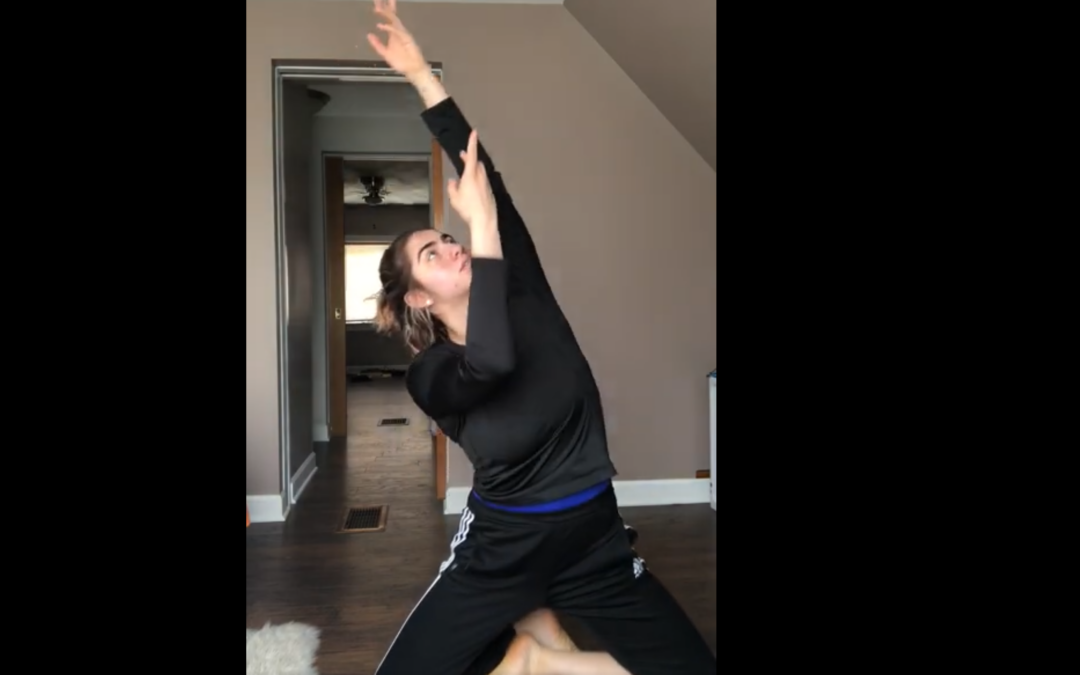As NIU and the world around us deals with a global pandemic, artists continue to find ways to express themselves. In the College of Visual and Performing arts the learning and teaching hasn’t stopped, it’s simply evolved to meet the needs and limitations of the situation. Over the coming days, we’ll be featuring how NIU students, alumni and faculty in the arts are continuing to do what they love.
The abrupt change to learning from home has been a challenge for all NIU students and faculty. In every challenge there is an opportunity and few groups were impacted more, or have responded as creatively as those studying and teaching dance in the School of Theatre and Dance.
Dance students take at least three dance courses a day, and so the faculty have created ways they can learn, stay in condition and dance from wherever their homes might be.
Students in Professor of Dance, Paula Frasz’s Choreography I course have suddenly found themselves studying nature, as well as dance.
“I live in Plano, Ill. and I have a horse and a dog, so I’m outside all the time,” Frasz said. “I was walking my dog when this whole coronavirus thing started to happen. We were walking by the creek and I was trying to figure out how I was going to be able to deliver my courses online. As I’m watching the creek, I saw something. It was a huge beaver and it slapped the water with its tail and dove down and I was like, ‘that is so cool!’
“There is all sorts of movement in nature and I’m out here at least a couple of times a day. Most of our students are either in the suburbs or the city. There are not a lot who live in the country and I thought, why don’t I share the movements I see in nature and have that be their inspiration?”
Frasz says in a beginning choreography class, students copy steps they have seen, or see in class.
“The whole idea is to make them find their own individual voice in choreography,” she said. “To invent new movement. So I send them videos or shots of things I see in nature, to make them find their individual voice in choreography, to invent new movement. So as they choreograph their moves to interpret what they see in the videos, it gives them some structure and trains their eyes to make them see and analyze the movement they just saw.”
Students have been sending back short videos of moves they have choreographed, and their final project will be to perform a three minute solo dance routine.
Here’s an example of one of Frasz’s assignment videos sent to her students:
And short clips sent back from her students.
Gabrielle Knecht
Victoria Herrera
“It should be nice outside and they can put all those movements together in any order,” she said. “They can repeat them, or they can skip some. I’m sending them a wide variety so some of the movements are percussive–like when I throw a rock into the creek and there’s a big splash. Some are really slow, like a vine climbing up a tree that grows an inch every six months. Some that I have taped don’t even have any movement. I found a fungus that was repeated 1,000 times on a tree. That’s repetition.”
The prerequisite for the choreography class is in improv class where students study movement qualities laid out by Rudolf Laban.
“Movement can be suspended,” Frasz said. “It can collapsed, it can be migratory, it can be percussive, it an be swinging…so the students have to be able to analytically organize their thoughts. It causes them to really think about what they’re doing choreographically.”
Are you a student, alumni or faculty member in the NIU College of Visual and Performing Arts with video of yourself performing or creating, or photos of a finished product? Use this form to share it with us.

